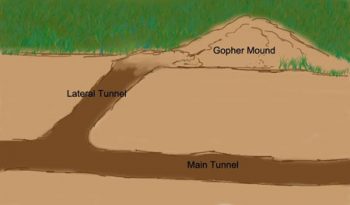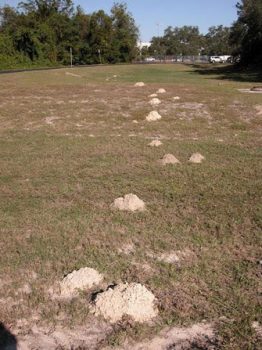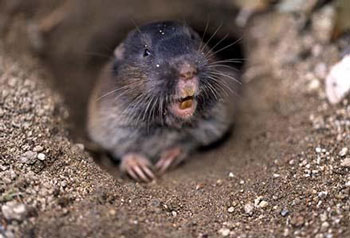Pocket gophers are a burrowing rodent that commonly destroys:
- Landscaping
- Underground irrigation systems
- Underground Conduit ~ Within the Phoenix metro area!
Pocket gophers are common in:
- Yards
- Parks
- Schools
- Agricultural fields ~ Throughout the Phoenix metro area!
Once pocket gophers have infested your yard they can be very destructive. It is common to find large mounds where the pocket gophers will have pushed out the dirt moved during the excavation process of creating their underground runway systems or underground burrows.
The pocket gopher will typically dig down several feet and then dig laterally to cover large distances in order to access the underground root systems of different plants for their nutritional needs. It is common to find pocket gophers burrowing along concrete curbs, sidewalks, fence lines, or even the foundation of your home.


Pocket gophers can destroy the burms in yards that retain irrigation water, causing the irrigation water to leak profusely. Pocket gophers have even been known to dig under the foundation of a house, find the bath trap, a small 12’’ x 12’’ area that is under your bath tub that is exposed to the open earth, then dig up dirt out of their hole underneath the tub and actually blow out the drywall from their efforts. Gophers have also been known to dig down under a house and come up under the sump-pump in a basement! They also can go under block footers, concrete walkways, or even drive ways loosening the dirt to the point that it will jeopardize the structural integrity of the concrete.


Pocket gophers breed year round, but are most active in the warmer months. The pocket gopher will have a burrow where it will give birth to 8-12pups; those pups will reach maturity in 2-3months. There are some areas in Phoenix where utility companies actually bury their underground conduit with steel braided hose, encasing it in order to prevent pocket gophers from chewing through and doing damage. Some parks or schools that are next to agricultural areas will commonly have hundreds of mounds present. In areas where there is livestock, gopher runway paths have been attributed to a horse breaking its leg because it fell into gopher holes or the ground caved in due to weakening by underground excavation efforts.
Pocket gophers are generally a neighborhood problem. If you have them, your neighbors will have them. The park next to you will have them, and even the field next to your property could have them. There is no easy way to combat them; basically the Anteater Exterminating, Inc certified service technician knows the habits of gophers and where to look to find their underground runways paths.


Once the Anteater Exterminating, Inc. technician has located their underground runways paths, he uses a special application tool to place bait in those subterranean runway tunnels. The gophers consume the bait and die. If you have a heavy gopher infestation it is common that we will have to perform an intensive treatment and then come back in 7-10 days, and then follow up again in another 7-10 days.
Gophers may require that you have a regularly scheduled service. If you’re in an area having high gopher populations such as landscaped yards that have irrigation or yards that are next to fields, then you are sure to have chronic gopher problems. Having gopher services preformed once a month or even twice a month may be necessary. There really is no secret to pocket gopher control except just persistence. The pocket gophers are persistent and therefore when treating for them you will also to have to be more persistent! You consistently place bait out for them to consume; replenishing the bait in their new runway paths.
Care must always be taken if you have pets that dig, such as dogs or pigs. As they may be able to dig down to the runways paths where the bait has been dispersed. Therefore if you have such a condition you should not treat pocket gophers with bait, but rather consider using traps. Traps are effective but require a high degree of maintenance. They have to be serviced frequently and each trap only eliminates one gopher at a time. As opposed to using bait that can be put out in 7-10 days intervals and then maybe only once a month after that. Trapping requires daily attention in the beginning and then every 3-4 days to follow up. Trapping requires scheduled intervention for weeks then months to gain the same type of control you would have gotten if using a less frequent baiting system.


There are certain tricks that make baiting more effective. First you have to locate the runways paths and make sure that you are deploying the bait underground. You use special application equipment where the bait cannot be dropped accidently in the yard and is deployed from the end of the probe utilized to find the runways paths through a trap door that’s opened after the probe has been inserted into the subterranean runway path.
If you have loose soil you may want to put water around the probe to prevent soil from falling down the hole and covering the bait and then you may need to place small wads of news paper before you cover up the hole again in an effort to not cover up the bait and make it more palatable for the pocket gopher to consume.
In some yards in residential subdivisions, Anteater Exterminating, Inc. can in some instances eliminate the pocket gopher infestations. But once again if you’re in an area that borders agricultural land, you live on horse property, or you have irrigated yards chances are gophers will be an ongoing problem you will need to contend with long term scheduled treatments.
